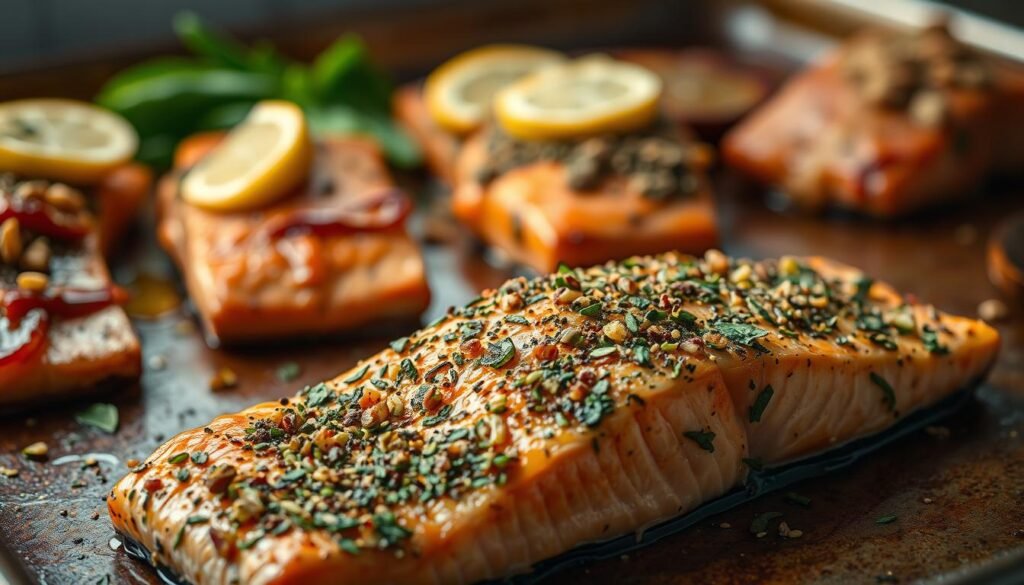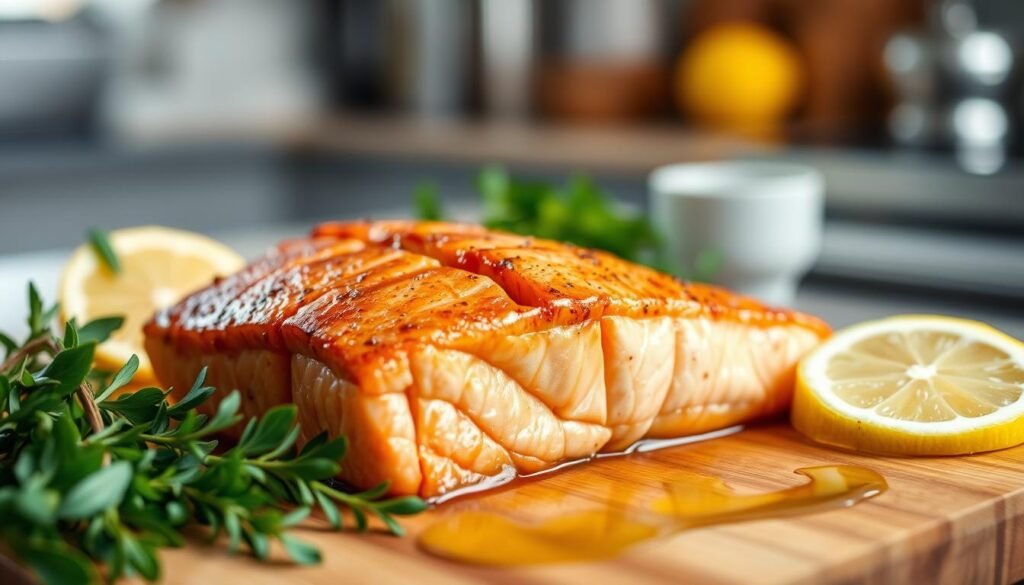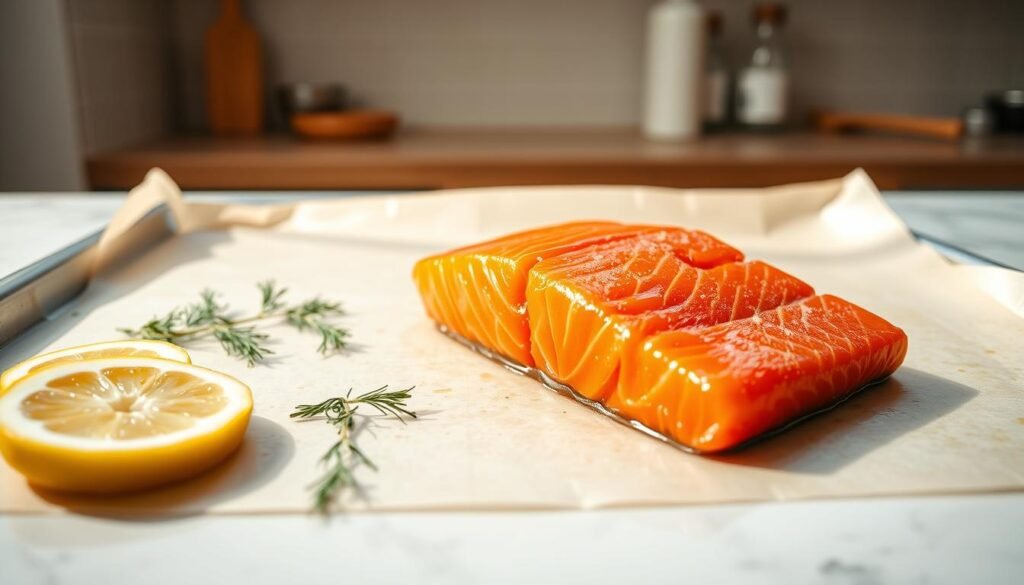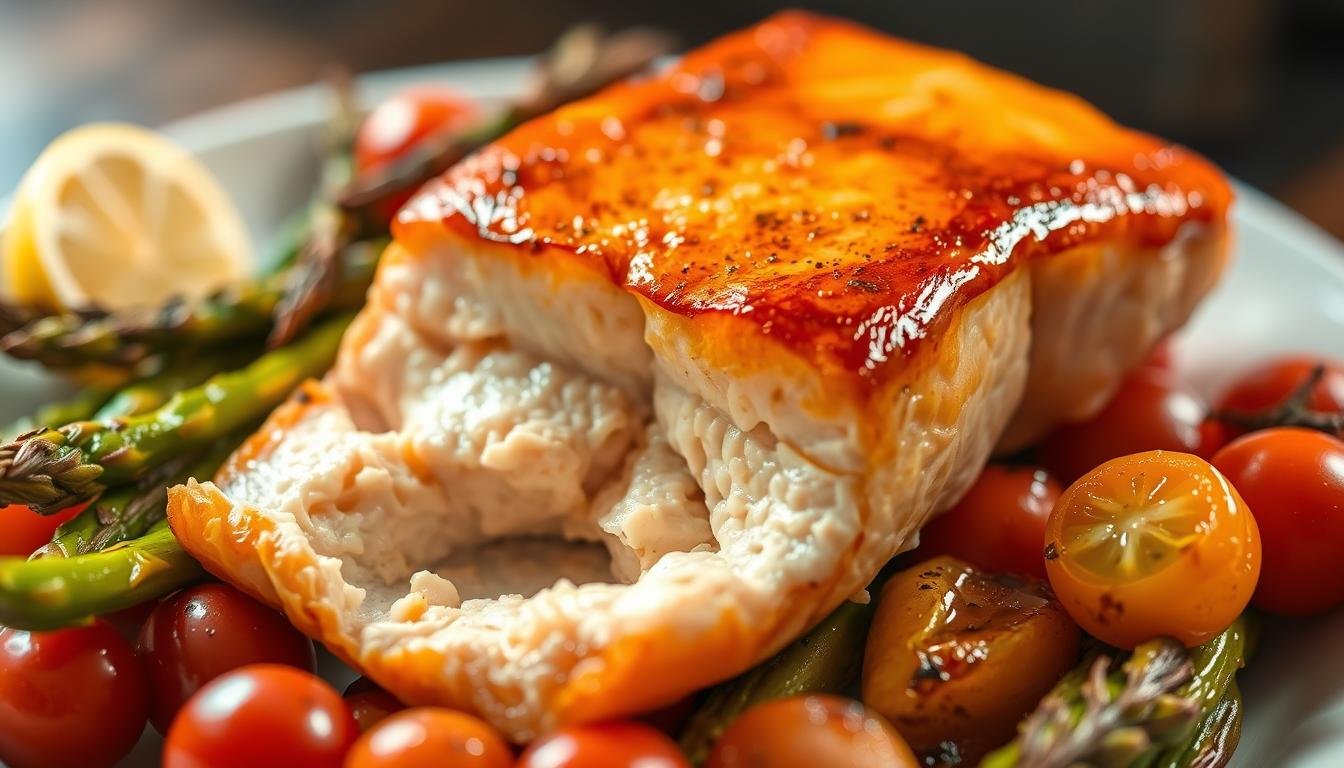How Long to Cook Salmon in the Oven? Cooking oven-baked salmon to perfection can be tricky. But with the right tips, you can make it moist and flavorful every time. The secret is knowing what affects cooking salmon in the oven.
The thickness of the salmon, the oven’s temperature, and whether the skin is on or off are key. Salmon in the oven cooks fast. But, it’s important to watch it closely to prevent overcooking.
Learning to cook salmon in the oven will help you make a tasty and healthy meal. It’s sure to impress your guests. Let’s explore the details to get you started.
Contents
- 1 Understanding Salmon Varieties and Cuts
- 2 Preparing Salmon Before Baking
- 3 Essential Equipment for Oven-Baked Salmon
- 4 Seasoning Options for Flavorful Salmon
- 5 How Long Do You Cook Salmon in the Oven?
- 6 Temperature Guidelines for Perfect Salmon
- 7 Different Oven Methods for Cooking Salmon
- 8 How to Tell When Salmon is Perfectly Cooked
- 9 Health Benefits of Including Salmon in Your Diet
- 10 Common Mistakes When Baking Salmon
- 11 Quick and Easy Oven-Baked Salmon Recipes
- 12 Conclusion: How Long to Cook Salmon in the Oven?
- 13 FAQ
- 13.1 What is the ideal temperature for cooking salmon in the oven?
- 13.2 How do I know when salmon is cooked to perfection?
- 13.3 Can I cook salmon from frozen in the oven? How long to cook frozen salmon in the oven?
- 13.4 What are some common seasonings for oven-baked salmon?
- 13.5 How long should I cook salmon in the oven for?
- 13.6 Can I use aluminum foil or parchment paper when baking salmon?
- 13.7 What are the health benefits of eating salmon?
- 13.8 How do I prevent overcooking salmon in the oven?
Understanding Salmon Varieties and Cuts
To master baking salmon, knowing the differences between types and cuts is key. The type and cut of salmon you pick can change how long it cooks and the taste of your dish.
Salmon comes in several types, like Atlantic, Sockeye, Chinook, Coho, and Pink. Each type has its own taste and texture. For example, Sockeye salmon is known for its rich flavor and firm texture, making it a favorite for baking.
The cut of salmon also matters for cooking time. Salmon can be found in cuts like fillets, steaks, and whole fish. Fillets are the most commonly used cut for baking because they cook evenly and are easy to season.
| Salmon Type | Flavor Profile | Texture | Cooking Time Adjustment |
|---|---|---|---|
| Atlantic Salmon | Mild | Soft | Shorter |
| Sockeye Salmon | Rich | Firm | Longer |
| Chinook Salmon | Rich, fatty | Firm | Longer |
Knowing these differences helps you adjust cooking time and method for the specific salmon type and cut. This ensures your dish turns out perfectly every time.
Preparing Salmon Before Baking
To bake salmon perfectly, start with the right preparation. Preparing your salmon correctly involves a few key steps. These steps ensure it bakes evenly and keeps its flavor.
First, clean and pat dry the salmon. Patting the salmon dry is a critical step that removes excess moisture. This allows the salmon to bake more evenly.
The Importance of Patting Dry Salmon
Patting dry salmon improves its texture and flavor. When the salmon’s surface is dry, seasonings stick better. The heat from the oven can also penetrate more evenly.
Then, season the salmon as you like. Use simple salt and pepper or complex marinades. The dry surface helps the seasonings stick better. Handle the salmon gently to avoid breaking it, especially if it’s a fillet.
Knowing the cooking time for salmon and the ideal salmon temperature is key. These details will be covered later. But proper preparation is essential for a successful bake.
By following these steps, you’ll bake salmon that’s delicious and perfectly cooked.
Essential Equipment for Oven-Baked Salmon
To get perfectly cooked oven-baked salmon, you need the right tools. The baking sheet or pan you choose is key.
A rimmed baking sheet or a broiler pan is best for baking salmon. They let air circulate around the fish for even cooking. A rimmed baking sheet also catches any juices, making cleanup simple.
The material of your baking sheet or pan matters too. A heavy-duty aluminum baking sheet or a stainless steel pan is best. They heat evenly and can handle high oven temperatures.
Using parchment paper or aluminum foil can improve your salmon. Parchment paper makes cleanup easy. Aluminum foil keeps moisture and flavor in. Just wrap the salmon in foil with your favorite seasonings and herbs, then bake.
Good air circulation is crucial for a crispy outside and a tender inside. Make sure to leave enough space between each salmon piece. Don’t overcrowd the pan.
With the right equipment and techniques, you can make delicious oven-baked salmon. It’s sure to impress everyone.
Seasoning Options for Flavorful Salmon
Choosing the right seasonings can really make your salmon taste better. Seasoning is more than just adding flavor. It’s about bringing out the best in the salmon.
Simple Herb and Spice Combinations can make your salmon dishes even better. Let’s look at some of these combinations.
Simple Herb and Spice Combinations
Using herbs and spices is a simple way to season salmon. A mix of dill, lemon juice, and garlic adds a refreshing taste. Or, try a blend of paprika, thyme, and cayenne pepper for a smoky flavor.
- Dill and lemon
- Thyme and rosemary
- Garlic and parsley
If you like a little heat, add red pepper flakes or sliced jalapeños. For a sweet and savory taste, mix soy sauce, brown sugar, and ginger.

Try different marinades and rubs to add more flavor. A Mediterranean marinade with olives and sun-dried tomatoes takes you to Greece. Or, a dry rub with chili powder and cumin gives a bold Southwestern taste.
By trying these salmon recipes and seasoning options, you can find the perfect way to enjoy cooking salmon.
How Long Do You Cook Salmon in the Oven?
Learning to cook salmon in the oven is all about the right cooking time for salmon. This salmon cooking in the oven includes fillet, stuffed, and sockeye too. The thickness of the salmon and the oven temperature are key. They decide how long you should cook it.
Start by preheating your oven to 400°F (200°C). The cooking time changes with the salmon’s thickness. A good starting point is 4-6 minutes per half-inch of thickness.
If your salmon is 1 inch thick, bake it for 8-12 minutes. It’s important to check the salmon often towards the end. This helps avoid overcooking.
To check if your salmon is done, you can use a few methods. One way is to see if it flakes easily with a fork. Another is to use a meat thermometer. The internal temperature should be 145°F (63°C).
Here’s a simple guideline for different salmon thicknesses:
- For 1/2 inch thick salmon, cook for 4-6 minutes.
- For 3/4 inch thick salmon, cook for 6-9 minutes.
- For 1 inch thick salmon, cook for 8-12 minutes.
By following these guidelines and adjusting the salmon cooking time for your oven and salmon, you can cook it perfectly every time. [How long to cook salmon in the oven at 400?]
Cook salmon in the oven at 350°F (175°C) for 20–25 minutes until it flakes easily with a fork. For thick fillets, bake up to 30 minutes for full doneness. [How long to cook salmon in the oven at 350?]
Temperature Guidelines for Perfect Salmon
When baking salmon, controlling the temperature is key. The best oven temperature is between 400°F to 425°F (200°C to 220°C). This ensures the fish is cooked well without drying out.
Key Temperature Guidelines:
- Preheat your oven to the desired temperature before placing the salmon inside.
- Use a thermometer to check the internal temperature of the salmon. The recommended internal temperature is 145°F (63°C).
- Avoid overcooking, as it can make the salmon dry and tough.
To ensure your salmon is cooked to perfection, it’s essential to monitor its internal temperature.
Here are some general guidelines for cooking salmon at different temperatures:
- At 400°F (200°C), cook for 12-15 minutes.
- At 425°F (220°C), cook for 8-12 minutes.
The thickness of the salmon fillet and your preference for doneness can change cooking times. Always use a thermometer to ensure the salmon has reached a safe internal temperature.
Different Oven Methods for Cooking Salmon
Oven-baked salmon can be cooked in various ways, like baking and broiling. These methods help you get the perfect taste and texture. Knowing how to use them can make your salmon dish even better.
Baking is a simple and classic way to cook salmon. You place the salmon on a baking sheet, add your favorite seasonings, and bake at a moderate heat. This method ensures the salmon cooks evenly and stays moist.
Broiling uses high heat to cook the salmon fast, making the outside crispy. It’s great for a crispy skin and a soft inside. But, you need to watch it closely to avoid overcooking.
Choosing between baking and broiling depends on your salmon’s thickness and what you want. Thicker fillets might do better with baking. Thinner ones can be broiled quickly.
- Advantages of Baking:
- Even cooking and moisture retention
- Easy to season and add aromatics
- Suitable for thicker salmon fillets
- Advantages of Broiling:
- Quick cooking time
- Crispy exterior and caramelized flavors
- Ideal for thinner salmon fillets or when time is limited
Whether to bake or broil salmon in the oven depends on your taste, available tools, and the salmon’s type. Try both methods to see which one you like best.
How to Tell When Salmon is Perfectly Cooked
To cook salmon just right, you need to look for visual signs, feel its texture, and check the temperature. There are a few ways to make sure your salmon is cooked perfectly.
Visual and Textural Cues
- Check for flakiness: Salmon is done when it flakes easily with a fork.
- Observe the color: Cooked salmon should have an opaque appearance.
- Texture: It should feel firm to the touch but still retain a tender texture.
Using a Thermometer for Precision
For a more precise method, using a thermometer is highly recommended. The internal temperature of cooked salmon should reach 145°F (63°C). Insert the thermometer into the thickest part of the salmon to get an accurate reading.

Here are some additional tips for cooking salmon:
- Preheat your oven to the right temperature before baking.
- Season the salmon as desired before cooking.
- Keep an eye on the cooking time, as it varies based on the thickness of the salmon fillet.
By combining these methods, you can achieve perfectly cooked salmon every time. Whether you’re a seasoned chef or a beginner in the kitchen, understanding the signs of doneness will elevate your cooking skills.
Health Benefits of Including Salmon in Your Diet
Salmon is packed with omega-3 fatty acids and proteins, making it a great choice for your health. Adding salmon to your meals can boost your overall well-being. It’s full of omega-3 fatty acids, protein, and vitamins and minerals.
Salmon’s high omega-3 fatty acid content is a big plus. These fats help your heart by reducing inflammation and improving blood fats. They also support brain health and may help with depression symptoms.
Salmon is also a top source of protein, key for muscle growth and repair. It’s loaded with vitamins like vitamin D and B vitamins, and minerals like selenium. Selenium is an antioxidant in the body.
Adding salmon to your diet can bring many health benefits, such as:
- Supporting heart health through omega-3 fatty acids
- Aiding in brain function and mental health
- Providing essential protein for muscle repair
- Boosting vitamin and mineral intake
To enjoy these benefits, try different salmon recipes. You can bake, grill, or poach it. Salmon is a versatile and nutritious choice for any meal.
Common Mistakes When Baking Salmon
To get your salmon right, knowing common mistakes is key. Baking salmon is easy and rewarding, but some errors can ruin it. Overcooking and Undercooking are big mistakes. Overcooking makes salmon dry and tough, while undercooking makes it unsafe.
Understanding the right salmon cooking time is crucial. This time changes based on the salmon’s thickness and the oven’s heat. [How Long to Cook Salmon in the Oven?]
Here are some tips for perfectly cooked salmon:
- Use a meat thermometer to check the salmon’s internal temperature. It should be 145°F (63°C) for safety.
- Watch the cooking time. A good rule is to bake for 4-6 minutes per half-inch of thickness.
- Don’t overcrowd the baking sheet. This can mess up even cooking.

Preparation is also key. Not drying the salmon or not seasoning it right can affect the taste and texture. Proper preparation boosts the salmon’s flavor and texture.
By avoiding these mistakes, you can always make delicious salmon. Knowing how to cook salmon boosts your confidence and makes meals better.
Quick and Easy Oven-Baked Salmon Recipes
Try our quick and easy oven-baked salmon recipes for a delicious meal. They’re great for busy weeknights when you need a healthy meal fast. [How Long to Cook Salmon in the Oven?]
To cook salmon in the oven, start by preheating your oven to 400°F (200°C). Line a baking sheet with aluminum foil or parchment paper for easy cleanup. Place the salmon fillet on the prepared baking sheet. Drizzle with olive oil and season with your choice of herbs and spices. Bake for 12-15 minutes or until the salmon is cooked through and flakes easily with a fork.
You can vary these recipes by changing the seasoning. For example, try a lemon garlic butter sauce by mixing softened butter with minced garlic and lemon juice, then spreading it over the salmon before baking. Another option is to add a Mediterranean twist with olives, tomatoes, and oregano.
| Seasoning Option | Ingredients | Flavor Profile |
|---|---|---|
| Lemon Garlic | Lemon juice, garlic, butter | Bright, savory |
| Mediterranean | Olives, tomatoes, oregano | Herby, slightly salty |
| Asian-Inspired | Soy sauce, ginger, sesame oil | Umami, slightly sweet |
These quick and easy oven-baked salmon recipes are not only delicious but also versatile. They let you experiment with different flavors to suit your taste.
Conclusion: How Long to Cook Salmon in the Oven?
Now you know how long to cook salmon in the oven and different ways to do it. Cooking salmon is more than just following a recipe. It’s about understanding the details that make a dish stand out.
Mastering salmon cooking opens up a world of flavors and textures. It can improve your cooking skills, no matter if you’re experienced or just starting. Salmon’s versatility lets you try different seasonings and cooking methods to make a dish that suits your taste.
Keep exploring oven-baked salmon and remember, practice is key. Try new recipes and techniques, and adjust cooking times to your liking. With patience and creativity, you’ll soon be cooking salmon like a pro. You’ll also enjoy the health benefits of eating this nutritious fish.
See Also: Why Does My Oven Smell Like Plastic the First Time?
FAQ
What is the ideal temperature for cooking salmon in the oven?
Cooking salmon in the oven should be done at 400°F to 425°F. This depends on the salmon’s thickness and type.
How do I know when salmon is cooked to perfection?
Salmon is perfect when it hits 145°F inside. It should also flake easily with a fork. Look for opaque flesh and a firm texture to check.
Can I cook salmon from frozen in the oven? How long to cook frozen salmon in the oven?
Yes, you can cook salmon from frozen in the oven — no need to thaw it first. Bake at 400°F (200°C) for 25–30 minutes until it’s fully cooked and flakes easily with a fork.
What are some common seasonings for oven-baked salmon?
Popular seasonings include lemon juice, garlic, dill, thyme, and olive oil. Try marinades or rubs for extra flavor.
How long should I cook salmon in the oven for?
Cooking time varies by salmon thickness and type. Cook for 4-6 minutes per half-inch. [How Long to Cook Salmon in the Oven?]
Can I use aluminum foil or parchment paper when baking salmon?
Yes, using foil or parchment paper makes cleanup easier. It prevents salmon from sticking to the sheet.
What are the health benefits of eating salmon?
Salmon is packed with protein, omega-3s, and vitamins. It’s great for heart health and overall nutrition.
How do I prevent overcooking salmon in the oven?
Use a thermometer to check for 145°F. Also, look for opaque flesh and flaking to avoid overcooking. [How Long to Cook Salmon in the Oven?]

Hi, I’m Leland Benson from Los Angeles. I studied marketing and worked 5 years at LG, selling ovens. From my job, I learned what things are safe to put in ovens. Now, I share simple advice to help you cook safely.

